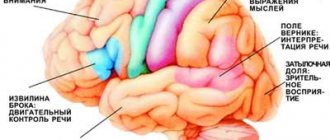Unpleasant sensations and pain in the head and eyes are familiar to everyone. This condition often only indicates overfatigue of the visual analyzer, especially during prolonged work at the computer. Therefore, when the eyes hurt when the pupils move, and a person feels dry, as if sand had gotten into them, at the first stage it is necessary to give the eyes a rest (especially if you feel pain in the eyes when working at the computer or reading). However, if this does not help, then it is necessary to exclude pathological processes that manifest themselves with similar symptoms from the visual analyzer. It can be:
- 1. Increased intraocular pressure. In this case, a person most often feels that the eye hurts inside. This condition can be transient and accompany, for example, migraine or brain pathology, or it can be permanent and lead to gradual retinal detachment associated with glaucoma. In this case, the eyeball becomes rocky when palpated.
- 2. Infectious diseases of the eyes, brain and intoxication. Inflammation of the mucous membrane of the eye - conjunctivitis - is a common cause of pain when blinking and at rest. Pain in the orbit that occurs when moving the eyes indicates that the eye muscles and nerves are involved in the inflammatory process. This situation can occur both during intoxication due to common flu or acute respiratory infections, and during such serious diseases as meningitis, encephalitis, etc. Inflammation of the paranasal sinuses (sinusitis or sinusitis) can cause pain in the nose and eyes. With the development of complicated forms of these diseases, pus can penetrate into the orbital cavity.
- 3. Trauma to the eyeball, head and facial skull can lead to pain in the orbits and eyes. The reason is direct mechanical impact or the entry of foreign objects into the visual analyzer. A concussion may also cause pain in the forehead or temple when moving the eyes.
- 4. Diseases of the eye appendages. A number of diseases can lead not to an eye problem, but to inflammation of the lacrimal glands (dacryocystitis) or eyelids (maybeitis).
What to do if you have a headache when you move your eyes?
Headache when moving the eyes and at rest (whether it is pain in the eyes when reading or working on a computer) is an extremely unpleasant condition for a person. Therefore, it is urgent to take a painkiller from the group of non-steroidal anti-inflammatory drugs. The next step in helping a person is to see a doctor. If there are signs of a general infectious disease (flu, acute respiratory infections), then a general practitioner will be able to provide adequate medical care. In other cases, consultation with an ophthalmologist and often a neurologist is necessary. If the cause of pain in the eye is a foreign object or injury, in no case should you rub your eyes or try to reach such an object directly with your fingers. It is necessary to rinse your eyes generously with clean water. If this does not produce results, seek medical help immediately.
Treatment methods
At the Clinical Brain Institute, treatment is selected individually. The scheme will include two main stages - getting rid of the main cause of the disease and its symptoms. Depending on the stage of the disease and its clinical manifestations, treatment is carried out at home or in a hospital. Several stages can be assigned, which are combined with each other.
- Drug treatment is the first stage for any disease. For headaches that radiate to the right eye, painkillers and antispasmodics, vitamins, and drugs to improve cerebral circulation are effective. In case of high blood pressure, infectious diseases, metabolic pathologies, you should take specific medications to improve the condition, which are prescribed only by a doctor.
- Physiotherapy is an equally important stage of treatment. It is effective for chronic pain and old inflammatory processes, consequences of injuries. Exposure to heat, magnetic radiation, electrical impulses irritates tissues, stimulates blood circulation and innervation.
- Massage is one of the methods of treating headaches associated with muscle spasms, diseases of the cervical spine, and the consequences of injuries. It is important to contact a specialist who will take into account all the physiological characteristics of the patient and help get rid of painful sensations. For acute inflammation, the method is not used.
- Treatment of eye diseases is prescribed by an ophthalmologist. He may prescribe glasses or contact lenses, which are made individually, depending on the results of the examination. Chronic diseases may require the use of antibiotics, anti-inflammatory and specific groups of drugs.
Surgical treatment methods are rarely used. The need for them arises with tumors and hematomas that compress nerve tissue, as well as with other neoplasms. At the Clinical Institute of the Brain you can get detailed advice on headache treatment methods, undergo examinations and receive competent advice from specialists. It is important to contact early, while diagnosis and treatment can improve your well-being, and not wait for irreversible changes.
Treatment for eye movement disorders
There are many reasons why the eyes hurt and there is a violation of their movement. However, this combination of symptoms indicates a severe pathology, where self-medication is inappropriate. Disorders of eye movements occur most often due to neurological pathology (diseases of the cranial nerves or circulatory disorders in the brain). An infectious process in the orbit can lead to a temporary disturbance in movement and a condition where the eye muscles hurt when moving upward (most often, such symptoms are observed with inflammation in the lower fornix of the orbit). Treatment of eye movement disorders can only be carried out by an ophthalmologist in joint consultation with related specialists (neurologists, neurosurgeons). If pain in the eye when moving the eyeball haunts you, contact the Neuro-Med clinic for help. Our specialists will advise you in detail on all issues, as well as prescribe suitable treatment.
Methods for diagnosing headaches
The Clinical Brain Institute has developed special individual diagnostic programs. They will help determine why your head and right eye hurt and how to prevent further progression of the disease. At the first examination, it is important for the doctor to know the nature and intensity of the headache, its frequency and time of occurrence. You should also report any additional symptoms that, in the patient's opinion, may not be related to the headache.
In our center you can undergo a full examination if you have a headache that radiates to your right eye. Several techniques may be needed to obtain a complete picture.
- X-ray – images of the cervical spine are informative in the diagnosis of displacements, osteochondrosis, and curvature of the spine. They can also identify head injuries.
- Examination by an ophthalmologist - includes various methods of testing vision, as well as determining intraocular pressure. If necessary, he prescribes additional tests.
- Electroencephalography is a technique that allows you to assess the degree of brain function and the speed of transmission of nerve impulses. The test results can show indirect signs of tumors, circulatory disorders, and hematomas.
- Ultrasound of cerebral vessels (Dopplerography) is an analysis that is performed if atherosclerosis, vascular spasms, or blockage of their lumen in certain areas is suspected. Their early diagnosis is the main prevention of ischemic stroke.
- MRI and CT of the brain are the most informative and accurate studies that are prescribed for suspected tumors, areas of ischemia and necrosis, and hemorrhage. CT also helps to determine the condition of the blood vessels in the brain and promptly identify changes in their structure.
Timely diagnosis is the key to successful treatment. It is important to understand not only the general clinical picture, but also to determine what disorders laid the foundation for the disease. Doctors will prescribe an individual set of tests that will give a complete understanding of the patient’s condition.
Complications
Most often, the right side of the head and the right eye hurt due to migraine. This disorder causes pain in the right temporal lobe; with strong tension in the temporal artery, the pain spreads to the eye. In rare cases, the pain spreads to the heart area, which can provoke frequent urination.
Migraines can cause discomfort, which is accompanied by nausea and vomiting. Dizziness, severe drowsiness and increased fatigue may occur.
You need to understand that a distinctive feature of migraine is its manifestation in the morning. Along with the pain, severe irritability and nervousness may occur. Moreover, such manifestations quickly disappear after taking painkillers.
What to do if a symptom occurs
To alleviate pain before visiting a specialist, the first step is to restore normal sleep and give the body a rest. To do this, you can take an infusion of valerian. You should avoid drinking strong coffee drinks that contain caffeine. Instead, it is better to brew tea with the addition of thyme, mint and chamomile. You can reduce pain by applying cold to the place where it appears; for this it is better to make a compress using ice.
During the period of migraine and severe pain on the right side of the head, discomfort can be reduced with the help of special massage actions. To do this, you should very carefully massage the area where the pain is coming from with your fingers. The duration of such a massage should be at least 10 minutes. It must be remembered that in cases where the pain is caused by tumors, massage is prohibited.
You also need to know that folk remedies can help relieve discomfort only with mild symptoms. In the event of cerebral hemorrhages, vomiting, or dizziness, self-medication is prohibited. In such cases, effective treatment should only be determined by a specialist, since such manifestations cannot always be cured with medication.
It is important to understand that the first step is to determine the reason why the pain appeared on the right side. It is necessary to undergo an examination consisting of the following procedures:
- a deep blood test that allows you to see all possible deviations from the norm;
- computed tomography - to identify possible tumors and problems with blood vessels that cause pain;
- ophthalmological examination – necessary to exclude problems with the visual organs.
Further prescription of therapeutic therapy will directly depend on the cause of pain. During the examination, in case of short-term pain, specialists allow you to take painkillers. Often the patient is recommended to take Analgin, Spasmalgon or Citramon, as they relieve spasms, help dilate blood vessels and stop pain.
If you have a severe migraine on the right side of your head, you should take an anti-inflammatory drug that will help eliminate fatigue and relieve pain. It is important to increase the amount of water you drink and get more rest, preferably in the fresh air.
Causes
Pain in the area of the right eye and head can occur for many reasons, but there are several main ones, the manifestation of which cannot be self-medicated. Causes of prolonged headaches and discomfort:
- Prolonged fatigue and being under severe stress. Soreness may be accompanied by throbbing and discomfort in the area of the right eye. It often occurs when spending a long time at the computer or in front of the TV. In this case, pain on the right side can occur in the morning or evening and manifest itself as a stabbing sensation in the temple or forehead area.
- Bruises of various types. The slightest blow can lead to concussions, which ultimately lead to brain diseases.
- Glaucoma and other eye diseases. If one eye is affected, the patient experiences severe discomfort. The pathology may be accompanied by a prickly sensation in the eyes, and the image begins to float.
- Incorrect selection of contact optics (lenses or glasses). When wearing incorrectly selected optical accessories, discomfort may occur in one or both eyes, migraines may develop, lacrimation increases, and the eyes quickly become tired.
- Spasmodic attacks in blood vessels. If the load is not performed correctly, compression or damage to blood vessels occurs in the cervical spine. As a result of such a clamp, pain may occur in the right side of the head, minor hemorrhages causing discomfort. A migraine may develop, with pain radiating to the right eye. Additionally, nausea, absent-mindedness, and slight loss may appear.
- Osteochondrosis – can cause headaches, dizziness and pain in the neck and eyes. Symptoms can appear with varying intensity, both on the right side and on the left.
- Hematoma inside the skull, malignant formations, meningitis and a pre-stroke condition - all this can provoke pain in the head and eye area on the right side. Additionally, with these conditions, the patient may experience significant weight loss, morning sickness, and frequent cramps.
- Eye injuries and infectious diseases can also cause pain on the right side.
- Colds and diseases of the respiratory system.
- Damage to the vascular system.
Prevention
Most diseases cause pain, which is almost impossible to prevent. In this regard, there are no precise preventive measures. To prevent the development of unpleasant sensations, you should protect the body from overexertion. Mental and physical fatigue can negatively affect people's health.
To prevent severe headaches, you should spend more time outdoors. Also, regular exposure to the street will contribute to the overall strengthening of the body.
Attention should be paid to a healthy lifestyle, especially for people who have sedentary jobs. Adequate sleep is also important, the duration of which should be at least 8 hours a day. This time is enough for the body to regain strength and rest. To ease pain, you can, if possible, replace trips on public transport with walking.
It must be remembered that the more the patient protects himself from stress and various strains, the less pain will appear in the right side of the head and eyes.










